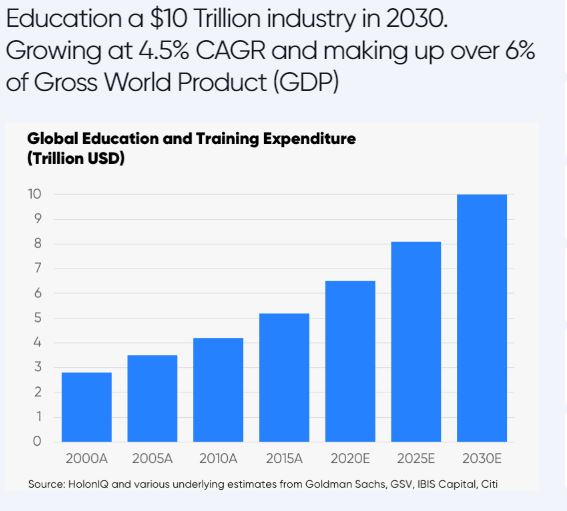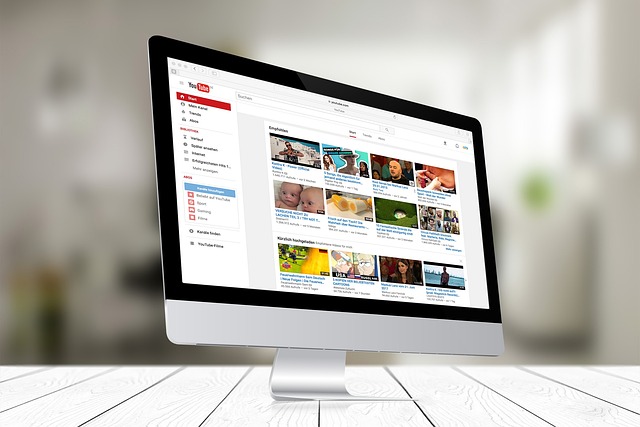In 2025, schools that optimize their websites and content for search engines will see increased visibility, leading to more inquiries and higher enrollment rates.

As we head into 2025, the education sector continues to evolve, driven by technological advancements, changing student preferences, and increased competition.
Schools must rethink their marketing strategies to engage prospective students and parents effectively. Traditional marketing methods alone no longer suffice; schools need to adopt digital marketing strategies that resonate with a tech-savvy audience.
This shift demands fresh, creative approaches, with an emphasis on content that is engaging, interactive, and informative.
According to Statista, global digital ad spending in the education sector is expected to reach $23 billion by 2025, reflecting the growing reliance on digital channels to connect with potential students.

Schools that leverage strategic content marketing are more likely to see higher engagement, improved enrollment rates, and stronger community ties.
Here are the top content ideas and strategies that will lead your 2025 education marketing initiatives, ensuring your institution stands out in a crowded market.
1. Virtual Campus Tours: Bringing the School to Students
With the rise of digital marketing for school education, virtual campus tours have become a staple for many institutions. They offer a way for prospective students and their families to explore the school environment without needing to visit in person.

These tours can include 360-degree videos, interactive walkthroughs, and even live virtual tours where participants can ask questions and interact with current students or staff.
Why Virtual Tours Matter:
- Accessibility: Students from different geographical locations can explore the school, broadening your reach.
- Convenience: Families can participate in tours from the comfort of their homes, making it easier to fit into busy schedules.
- Engagement: With the use of interactive elements, such as clickable hotspots, schools can provide deeper insights into facilities, programs, and campus culture.
A survey by NACAC found that 78% of students who participated in virtual tours felt more confident about their decision to apply to a particular school.
This statistic underlines the importance of adopting virtual tours as a core part of your school marketing strategy. As we move into 2025, schools must invest in high-quality virtual experiences to attract digital-native students.
2. Leveraging Social Media to Connect with Prospective Students
Social media platforms have become essential tools for education marketing strategies. With platforms like Instagram, TikTok, and YouTube dominating among younger audiences, schools must create engaging content that resonates with this demographic.

Social media is not just about sharing updates; it’s about building a community, showcasing the school’s culture, and interacting with students and parents.
Effective Social Media Strategies:
- User-Generated Content (UGC): Encourage students, alumni, and even parents to share their experiences using branded hashtags. This authentic content helps build trust and community.
- Short-Form Videos: Platforms like TikTok and Instagram Reels thrive on short, engaging videos. Schools can create content that highlights daily life, success stories, or quick campus tours.
- Interactive Features: Use features like polls, quizzes, and Q&A sessions to engage your audience and gather feedback.
Hootsuite reports that educational institutions that maintain active social media profiles experience a 62% higher engagement rate compared to those who do not.
For 2025, schools need to harness the power of social media by creating a consistent, engaging presence that showcases the essence of their institution.
3. AI-Powered Personalized Marketing: Tailoring Messages to Individual Needs
Artificial Intelligence (AI) has made significant inroads into marketing, and education marketing is no exception. Schools can use AI to analyze student data and deliver personalized marketing messages that address specific interests and concerns.

Whether it’s through chatbots, automated email campaigns, or personalized website content, AI can enhance the user experience by making it more relevant and engaging.
AI Applications in School Marketing:
- Chatbots: AI chatbots can provide instant responses to common inquiries, guiding prospective students through the admission process.
- Predictive Analytics: Use AI to analyze application trends and predict which marketing strategies are most effective.
- Personalized Content Recommendations: AI can suggest specific programs or courses based on user behavior and preferences, leading to a more personalized browsing experience.
According to Gartner, AI-powered marketing will drive a 30% increase in revenue for organizations that adopt it by 2025.
Schools that integrate AI into their marketing strategies can expect to see more efficient lead generation and higher conversion rates, making this a must-have tool in the coming years.
4. Content Marketing: Blogs, eBooks, and Resource Centers
Content marketing remains one of the most effective ways to engage with prospective students. By creating valuable content that addresses the needs and interests of students and their families, schools can position themselves as thought leaders and trusted resources.

Content marketing for school education can include blogs, eBooks, infographics, podcasts, and more.
Popular Content Ideas for Schools:
- “How to Choose the Right School” Guides: Offer detailed guides to help parents and students navigate the school selection process.
- Study Tips and Academic Resources: Provide helpful content that supports students academically, positioning the school as a supportive educational partner.
- Success Stories and Alumni Profiles: Showcase successful alumni to highlight the long-term benefits of attending the school.
According to the Content Marketing Institute, organizations that prioritize content marketing see 3x more leads than those who don’t.
For schools, this translates into higher visibility, increased brand authority, and more opportunities to engage with prospective students. As 2025 approaches, schools should focus on creating content that answers common questions and offers genuine value.
5. Email Marketing: Personalized Communication for Better Engagement
Email marketing continues to be a highly effective strategy for reaching out to prospective students. However, the key to success lies in personalization.

Generic emails often get lost in the clutter, but tailored messages that speak directly to the recipient’s interests can significantly increase open rates and engagement.
Tips for Effective Email Marketing:
- Segmentation: Divide your email lists into specific segments based on factors like age, location, interests, and previous interactions.
- Dynamic Content: Create emails that change content dynamically based on the recipient’s profile, making each email feel personalized.
- Clear CTAs: Ensure that every email has a clear call to action, whether it’s to schedule a campus tour, attend an open house, or complete an application.
Mailchimp reports that segmented email campaigns have a 14.31% higher open rate and a 100.95% higher click-through rate than non-segmented campaigns.
Schools looking to enhance their digital marketing strategies in 2025 should prioritize email marketing, focusing on building personalized, meaningful connections with their audience.
6. Hosting Webinars and Live Events: Engage in Real-Time
Webinars and live events provide an excellent opportunity for schools to showcase their programs, faculty, and campus culture to prospective students and their families.

These events can be used to address frequently asked questions, discuss academic programs in detail, and allow attendees to interact directly with staff and current students.
Benefits of Hosting Webinars:
- Direct Engagement: Live events allow schools to engage with prospective students in real-time, answering questions and addressing concerns directly.
- Cost-Effective: Unlike traditional open houses, virtual webinars can reach a wider audience at a fraction of the cost.
- Repurposable Content: Webinars can be recorded and used as on-demand content for future marketing efforts.
A survey by Inside Higher Ed found that 71% of prospective students consider virtual events helpful in making their enrollment decisions.
As 2025 approaches, schools should integrate webinars and live events into their marketing plans to reach a broader audience and build stronger connections.
7. Gamification: Making Learning Fun and Interactive
Gamification is the process of applying game-like elements to non-game contexts, and it has proven to be effective in education marketing. Schools can use gamification to create interactive and engaging learning experiences for prospective students.

This could include online quizzes, competitions, or interactive learning modules that showcase the school’s programs.
Ideas for Using Gamification:
- Quizzes and Competitions: Create fun quizzes that educate students about the school while engaging them in a playful activity.
- Interactive Challenges: Host virtual challenges that encourage prospective students to learn more about the school’s programs and win rewards.
- Progress Tracking: Use progress bars, badges, and certificates to incentivize students to complete tasks and engage with school content.
A study by Deloitte showed that gamification can increase student engagement by up to 40%.
By incorporating gamification into school marketing, educational institutions can make learning more engaging and create a memorable first impression on prospective students.
8. Influencer Marketing: Building Credibility Through Authentic Voices
Influencer marketing is becoming a powerful tool in education marketing. Schools can partner with influential figures in the education sector, alumni, or even popular student figures to promote their programs and campus culture.

Influencers can offer authentic, relatable insights into school life, which can resonate well with prospective students and parents.
How to Effectively Use Influencer Marketing in Schools:
- Partner with Alumni Influencers: Reach out to successful alumni who can share their experiences and stories about how the school helped them succeed.
- Collaborate with Education Influencers: Work with educational bloggers, YouTubers, and Instagram personalities to create content that highlights the school’s strengths.
- Student Takeovers: Allow current students with a strong social media presence to take over the school’s social media accounts for a day, showcasing a day in their life at the institution.
According to Mediakix, 89% of marketers say ROI from influencer marketing is comparable to or better than other marketing channels. As we head into 2025, leveraging authentic voices can help schools build credibility and connect more effectively with their target audience.
9. SEO Optimization and Content Marketing: Boosting Online Visibility
Search engine optimization (SEO) remains a critical component of digital marketing for school education. With so many schools competing for attention online, it’s essential to ensure that your institution ranks high on search engine results pages (SERPs).

Effective SEO practices combined with strategic content marketing can significantly improve visibility and attract prospective students.
Tips for Enhancing SEO in Education Marketing:
- Use Relevant Keywords: Include keywords like “best private school near me,” “top international school,” or “best school for STEM” throughout your website content to help it rank for relevant searches.
- Create Valuable Content: Write blogs, guides, and FAQs that address common questions prospective students and parents may have. High-quality content that answers queries effectively will perform well on search engines.
- Optimize for Mobile: Ensure your website is mobile-friendly, as a significant portion of web traffic comes from mobile devices. A fast, responsive website can improve your search engine ranking.
A report by BrightEdge shows that 68% of online experiences begin with a search engine, which highlights the importance of SEO for school marketing.
In 2025, schools that optimize their websites and content for search engines will see increased visibility, leading to more inquiries and higher enrollment rates.
10. Video Marketing: Capturing Attention with Compelling Visual Content
Video content continues to dominate the digital landscape, making it an essential element of effective school marketing.

From promotional videos to student testimonials and virtual campus tours, schools can use video marketing to showcase their programs, campus life, and success stories in a dynamic and engaging way.
Types of Videos to Include in Your Marketing Strategy:
- Campus Highlight Videos: Create a video tour that showcases the best aspects of your campus, including facilities, classrooms, and recreational areas.
- Student and Faculty Testimonials: Feature current students, alumni, and faculty members sharing their experiences and insights about the school. Authentic, first-hand accounts help build trust.
- Live Streaming Events: Host live sessions, such as virtual open houses, Q&A with faculty, or student-led webinars, to engage prospective students and their families in real time.
According to Wyzowl, 84% of consumers say they’ve been convinced to buy a product or service after watching a brand’s video.
Applying this to school marketing, compelling video content can help convert prospective students by giving them a glimpse into life at your school. As we move into 2025, schools must leverage video marketing to capture attention and create emotional connections.
11. Content Localization: Reaching Diverse Audiences with Tailored Messages
In a globalized world, many schools are looking to attract international students, and content localization has become a crucial strategy. Localization goes beyond just translating content; it involves adapting marketing messages to resonate with diverse cultural norms, values, and languages.

This approach ensures that your content feels more personal and relevant to students and families from different backgrounds.
How to Effectively Implement Content Localization:
- Translate Key Marketing Materials: Translate brochures, websites, and emails into the languages of your target regions. Ensure translations are accurate and culturally appropriate.
- Adapt Content to Cultural Preferences: Customize messaging, visuals, and examples to suit the cultural norms and expectations of the target audience. For example, using local idioms, holidays, and cultural references can make content more relatable.
- Leverage Regional Social Media Platforms: Use social media channels that are popular in your target regions. For example, schools targeting students from China may benefit from a presence on WeChat, while those focusing on the Middle East might consider platforms like WhatsApp and Instagram.
A study by Common Sense Advisory found that 72.4% of consumers are more likely to buy a product if the information is presented in their native language.
For schools, this means that localized content can significantly increase engagement and interest from international students. By implementing effective localization strategies, educational institutions can expand their reach and appeal to a broader audience in 2025.
12. Content Marketing Through Online Communities: Building Trust and Engagement
Building and nurturing online communities is a powerful way to engage prospective students and their families. Schools can create dedicated spaces, such as forums, social media groups, or community pages, where current students, alumni, staff, and prospects can interact.

These communities provide a platform for authentic conversations, allowing prospective students to ask questions, seek advice, and get a real sense of the school culture.
Strategies for Effective Community Building:
- Create Private Social Media Groups: Platforms like Facebook, LinkedIn, and even Discord can be used to set up private groups where prospective students can join, ask questions, and interact with current students and alumni.
- Host Virtual Open Houses and Community Events: Organize online events where students can participate in discussions, watch live demonstrations, or engage in Q&A sessions. These events help in building a sense of belonging even before the students join the school.
- Encourage Peer Mentorship: Set up peer mentorship programs where prospective students can be matched with current students or alumni. This helps prospects get personalized insights and advice, making them feel more confident in their decision-making.
A report from Sprout Social highlights that 64% of consumers want brands to connect with them. For schools, creating online communities is an opportunity to build trust and transparency, foster long-term relationships, and enhance engagement.
Moving into 2025, schools that invest in building strong online communities will be better positioned to attract and retain students by making them feel connected even before they set foot on campus.
Conclusion
In 2025, successful school marketing will hinge on understanding the digital behaviors and preferences of prospective students. Schools must embrace innovative content ideas and digital marketing strategies that prioritize engagement, personalization, and authenticity.
From immersive virtual tours and engaging social media campaigns to AI-driven personalization and gamified experiences, there are numerous ways to attract and connect with students.
By implementing these top content ideas, schools can enhance their digital marketing for school education, stand out from competitors, and build long-lasting relationships with students and families.
Are you ready to revolutionize your school’s marketing strategy for 2025?


Pingback: How 2025 Will Shape the Future of Education Policy in India
Pingback: The Future of AI in Education Marketing: Stay Ahead in 2025
Pingback: What Higher Education Marketing Will Look Like in 2025?
Pingback: Power of Personalized Video Messaging in Education Marketing
Pingback: Make Your University Stand Out as an Innovation Leader in 2025?